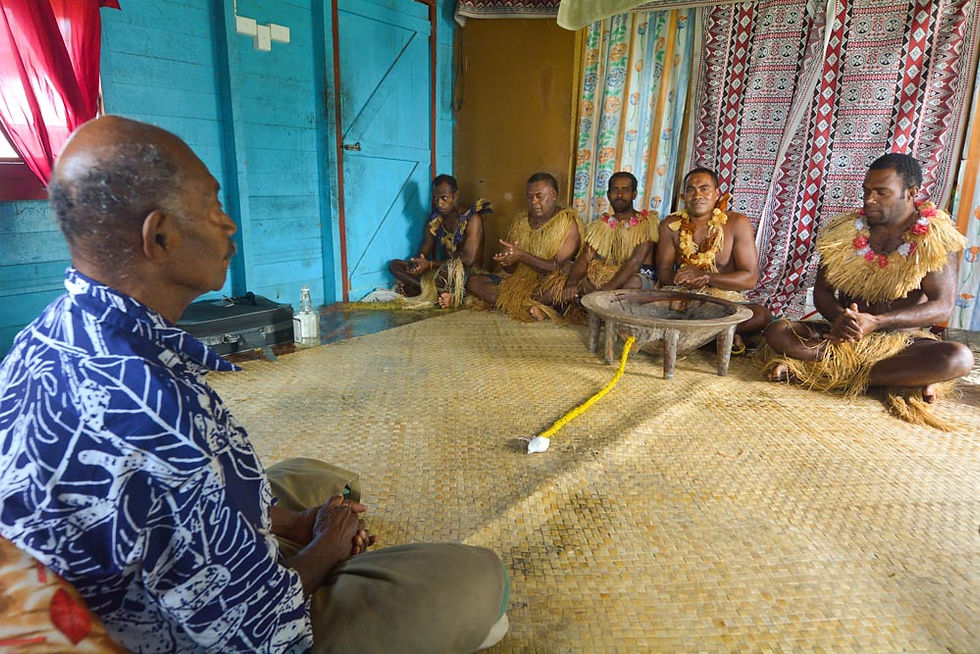Exploring Kava: A Journey Through Tradition & Modern Use
- Cannabis Cactus

- Aug 31, 2024
- 3 min read

As I wander through the city, I occasionally stumble upon kava bars—sometimes tucked away discreetly, other times bustling with activity. My own kava experience was a blend of social and ritualistic. I had the privilege of sampling kava from a ceremonial carved wooden bowl, a tradition deeply rooted in the Tongan community. The drink was slightly stimulating, with a grainy texture and a neutral taste, served in small 2 to 4-ounce servings. Intrigued by this experience, I wanted to learn more about the effects of kava, its cultural significance, and how it fits into the broader context of holistic and mental health therapies alongside cannabis, kratom, and mushrooms.

What is Kava?
Kava, also known as Piper methysticum, is a plant native to the South Pacific islands. The roots of the kava plant are used to create a drink that has been consumed for centuries in ceremonial and social settings, particularly in Tongan, Samoan, Fijian, and Hawaiian cultures.
The Effects of Kava
Kava is known for its calming and relaxing effects, which can vary depending on the strain and preparation method:
Relaxation and Stress Relief: Kava is renowned for its anxiolytic properties, helping to reduce anxiety and promote relaxation without impairing mental clarity.
Mood Enhancement: Many users report a sense of well-being and mild euphoria after consuming kava, making it a popular choice for social gatherings.
Sedation: In larger doses, kava can have sedative effects, aiding in sleep and relaxation.
Mild Stimulation: Some strains of kava can provide a mild stimulating effect, which may explain the slight stimulation I felt during my own experience.

Kava & Its Cultural Significance
In Tongan and Samoan cultures, kava is more than just a drink—it's a cornerstone of social and ceremonial life. The preparation and consumption of kava are steeped in tradition and ritual, symbolizing unity, respect, and community. The use of a ceremonial carved wooden bowl, as I experienced, is a testament to the cultural importance of kava. These rituals often involve chanting, storytelling, and communal bonding, reflecting the deep-rooted significance of kava in fostering social cohesion.
Comparing Kava, Cannabis, Kratom & Mushrooms
Kava, cannabis, kratom, and mushrooms have all found a place within the cannabis and counterculture communities, each offering unique benefits and experiences:
Cannabis: Known for its wide range of therapeutic benefits, including pain relief, anxiety reduction, and mood enhancement. It can be used both recreationally and medicinally.
Kratom: Popular for its stimulant and sedative properties, depending on the dose. It is often used for pain relief, energy boosting, and managing opioid withdrawal.
Mushrooms: Psychedelic mushrooms, particularly those containing psilocybin, are used for their profound mind-altering effects, aiding in mental health therapy and spiritual exploration.
Kava: Fits into this spectrum as a natural, non-psychoactive option that provides relaxation, stress relief, and social bonding without the intensity of psychedelics or the addictive potential of some substances.

The Holistic Approach to Mental Health & Recreation
In recent years, there has been a growing interest in holistic approaches to mental health and recreation. People are seeking natural alternatives to traditional pharmaceuticals, looking for ways to enhance their well-being and connect with themselves and others in a meaningful way. Kava fits into this trend perfectly, offering a gentle, natural way to relax and socialize.
For Tongan and Samoan communities, kava is a vital part of their cultural heritage. It embodies the principles of respect, unity, and tradition. The ceremonial preparation and consumption of kava foster a sense of community and continuity, preserving cultural practices that have been passed down through generations. In these cultures, kava is not just a drink but a symbol of social harmony and cultural identity.
My exploration of kava has deepened my appreciation for this remarkable plant and its cultural significance. As we continue to seek holistic and natural approaches to mental health and recreation, kava stands out as a valuable addition to our routines. Whether you're looking to relax, bond with friends, or explore a new cultural experience, kava offers a unique and enriching journey.
Until next time, stay curious and keep exploring the world of natural wellness.








Comments